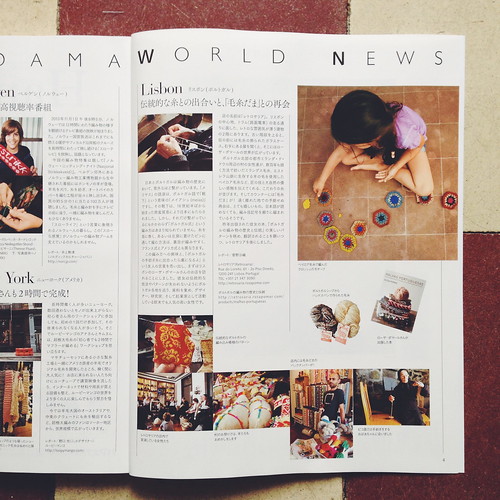A minha revista de tricot preferida traz no seu número mais recente uma página dedicada ao meu trabalho e à Retrosaria. Aqui fica a tradução, gentilmente enviada pela repórter:
Encounter with traditional Portuguese yarn in Lisbon
Reencounter with ”Keito Dama”
Do you know that the history of knitting in Japan and Portugal has something in common? When you started to learn how to knit, wasn’t it the ”meriyasu” pattern you knitted at first? In fact ”meriyasu” (meias) is a Portuguese word which means ”socks”. Knit socks were imported by Japan in the times of the Western trade which started in the mid of 16th century. But despite such a history Portuguese method of knitting which is different from American and Continental and in which the yarn goes over the neck or shoulder of the knitter making to knit ”purl” loop easier than ”knit” loop, is still not well known in Japan. I remembered friend of mine said that I would ”become captive” if I saw the traditional Portuguese yarn, so this time I decided to visit Rosa Pomar’s knit shop in Lisbon. She went around the country in search of traditional technique and patterns collecting them for tradition do not disappear. She is a designer, researcher and an entrepreneur; she is the woman who is popular in Europe and America.
The shop name is Retrosaria and it is located in the central Lisbon, on the street where the trams are running; on the second floor of the building with some ”retro” nostalgic atmosphere. Climb on old stairs and you can see the glass case with displayed woolen yarn. Open the door on the right side and you will be in the Rosa Pomar’s World. On the line of shelves one can see Mirandese yarns, which were hand spun by the women in the northern part of Portugal near the Miranda Do Douro, using the techniques which are existing for hundreds years; Beiroa yarns which were produced using wool of sheep breed in Estrela mountains and many others made by excellent hands with a gentle touch of the Nature. And, what a surprise! on the counter I spotted ”Keito dama”. I was so delighted to see it so far from Japan. And it is in use, because you can understand symbols even if you do not speak Japanese, I was told.
Finally I looked at beautiful knitted patterns inside her book ”The history and technique of knitting in Portugal“ which was published last year, and left Retrosaria with the hope that this book will someday be translated into Japanese.

Leave a Reply